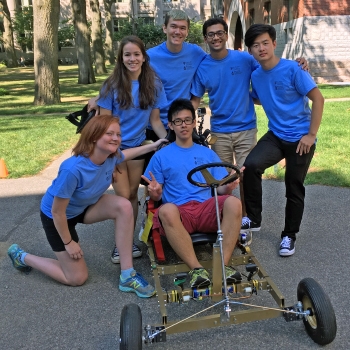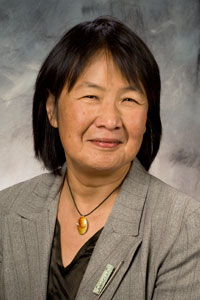News
Team Khrysos (students Lilian Magermans, Rebecca Gracia, Cameron Akker, Jainam Mehta, Howard Fu, and Jacky Cheng) built this personal electric vehicle from the ground up. (Photo provided by Lilian Magermans.)
When rain postponed a race between two student teams who had spent the summer building personal electric vehicles as part of a collaborative program at the Harvard John A. Paulson School of Engineering and Applied Sciences (SEAS), the students welcomed the extra time to fix last-minute problems with electrical and mechanical parts.
The next day the rain was gone and at the first light, the students, some still bleary-eyed from only a few hours sleep, met to conduct final tests of their vehicles. The initial runs around the course were intermittent, with bursts of movement followed by abrupt halts. As they learned to fine-tune their vehicles on the fly and coax out the best performance, each teammate triumphantly drove around the full course.
“We learned that the engineering design process involves a lot of failure, and you can either fail, become frustrated, and lose your patience, or fail and work as a team to solve your problems together,” said Yankang Yang, S.B. ’18, an electrical engineering concentrator.
Team Khrysos (students Lilian Magermans, Rebecca Gracia, Cameron Akker, Jainam Mehta, Howard Fu, and Jacky Cheng) built this personal electric vehicle from the ground up. (Photo provided by Lilian Magermans.)
Yang was one of 12 students who participated in the immersive summer program held at SEAS and the Hong Kong University of Science and Technology (HKUST). The seven-week program began in Hong Kong, where teams researched design ideas, drew up plans, and crunched numbers. They selected components for their vehicles based on a maximum budget of $1,500.
The teams, each comprised of students from both institutions, then traveled to Harvard and built cars from the ground up in the SEAS Active Learning Labs. The open-ended project challenged students to make decisions about everything from materials to fabrication techniques. Core guidance at both HKUST and SEAS was provided by Daniela Faas, Senior Preceptor in Design Instruction, Chris Lombardo, Associate Director for Undergraduate Studies in Engineering Sciences, and Avi Uttamchandani, Preceptor in Electrical Engineering.
Team Khrysos (named for the Greek god of gold) chose to build the frame for their three-wheeled vehicle from aluminum to reduce its weight, said Rebecca Gracia, S.B. ’18, a mechanical engineering concentrator. In addition to the fabrication experience they acquired as they drilled holes and fastened the chassis pieces together, teammates also learned the importance of quick trouble-shooting.
“After 10 minutes of driving our car, we noticed that the wheels were bending at 45-degree angles,” Gracia said. “The brackets, which were made of steel, looked like pieces of taffy.”
After borrowing spare parts from their fellow team, they were able to fix the problem and move on with the design.
Students Lilian Magermans (left) and Rebecca Gracia assemble the chassis for their team's personal electric vehicle. (Photo by Adam Zewe/SEAS Communications.)
Integrating so many different components, such as the motor driver and Arduino, proved to be another challenge, said teammate Lilian Magermans, S.B. ’19, a mechanical engineering concentrator.
“This project involved so many different subsystems,” Magermans said. “I had to work with components that I knew nothing about. But as a team, we all trusted each other, so we played off each other’s strengths.”
Team Drake Brum (a spoonerism of the phrase “brake drum”) took a different strategic approach; they built one version of the vehicle as fast as possible, and then created a second version to optimize any ineffective or inefficient components. They improved the strength of their three-wheeled chassis between versions, and after extensive testing, chose a simpler and more effective electrical system.
The roadblocks they overcame together showcased the challenges engineers face, said Ivraj Seerha, S.B. ’19, a mechanical engineering concentrator.
"People highly underestimate the emotional demands on an engineer. Being able to fight for, but then drop an idea that you just came up with, without attaching any ego to it, is very difficult to do,” he said. “The best engineers are the ones who have the best emotional fortitude.”
Ivraj Seerha takes measurements as he works on his team's electric vehicle chassis. (Photo by Adam Zewe/SEAS Communications.)
The teams celebrated their success during a project showcase for faculty members from SEAS and HKUST on July 29. They explained their design decisions during the afternoon presentation and, the next morning, demonstrated their vehicles.
It was gratifying to see their project driving down the road, Yang said, but equally rewarding were the friendships students forged as they learned from each other.
Fostering cross-cultural collaboration is a key aim of the summer program, which is now in its third year, said Evelyn Hu, Tarr-Coyne Professor of Applied Physics and Electrical Engineering. In addition to teaching valuable engineering and problem-solving skills, the program seeks to broaden students’ cultural horizons.
“Engineering is truly global. The economy is global and the role of engineers is profound when it comes to shaping and improving the world,” she said. “By providing a way for students to learn more about the world around us, we hope to encourage more opportunities for innovation. We want to build genuine bridges.”
Team Drake Brum (students Lisa Lu, Yangkang Yang, Spartey Chen, Dion Ng, Raphael Wong, and Ivraj Seerha) with their personal electric vehicle. (Photo provided by Lisa Lu.)
Topics: Electrical Engineering
Cutting-edge science delivered direct to your inbox.
Join the Harvard SEAS mailing list.
Scientist Profiles
Evelyn Hu
Tarr-Coyne Professor of Applied Physics and of Electrical Engineering
Press Contact
Adam Zewe | 617-496-5878 | azewe@seas.harvard.edu




